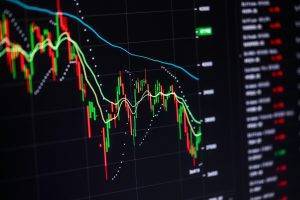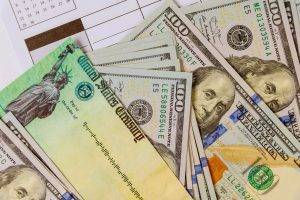Trade tremors and higher volatility will continue to dominate market moves in the coming week.
Last week, President Trump not only raised tariffs on $200 billion of Chinese goods to 25% from 10% but indicated possibly imposing tariffs on additional goods that have not been hit by levies yet, worth about $325 billion. In response, China’s Ministry of Commerce vowed to retaliate, although countermeasures have yet to be expressed.
Despite the higher levies on Chinese goods, officials on both sides met in Washington on Friday but hit an impasse with no date set to resume the discussions. President Trump gave the markets some hope of resolve on Friday after noting that trade conversations with China will continue and that his relationship with China’s President Xi remained strong. Both President Trump and President Xi are scheduled to attend the G-20 Summit in Japan next month.
While the impact of the initial 10% levies on Chinese goods seemed to just make a ripple within the U.S. economy, market practitioners noted that the increase to 25% may take its toll. For example, some economists see the new tariffs potentially resulting in fewer jobs and hurting supply chains across borders, resulting in slower global economic growth. Last week, Fed Official Bostic noted that the additional tariffs could incite inflation as consumers will ultimately be hit with higher prices (see more below).
All eyes will be on U.S. retail data later this week, particularly given that about two-thirds of U.S. GDP is comprised of consumer spending. It is expected, however, that any impact of the new tariffs will likely be reflected in data in the third quarter. China is also on the docket to report retail sales and on industrial production. Other notable data releases include Eurozone GDP and U.K. unemployment data.
Last week, all three major U.S. stock indices ended the week in the red, but, the S&P 500, Nasdaq and Dow Jones all enjoyed one-day gains on Friday as positive sentiment prevailed that an all-out trade war can still be avoided. The S&P 500 hovered near 2,881.4 at the close. Further, volatility remained elevated, as the Cboe Volatility Index, VIX, spiked to its highest level since January towards the end of the week.
The RISK-OFF sentiment prompted Treasury yields lower, with the 10-year Treasury ending the week around 2.473%. Earlier in the week, however, the Treasury Department held a $27 billion auction for 10-year notes, which resulted in poor demand for the paper with the lowest bid-to-cover ratio since March 2009. The weak demand coupled with the growing U.S. deficit, which is about $22 trillion (and more than double from where it was pre-crisis), may have some investors on alert as to potential upward pressure on yields going forward.
Finally, energy prices also fell over the week, with WTI crude trading around $61.71/barrel at the close. A protracted trade war could place downward pressure on energy prices, given the U.S. and China collectively accounted for over a third of global oil consumption in the first quarter of this year. On the flip side, energy prices will likely find support as supply remains constrained on the back of U.S. sanctions on Iran and Venezuela coupled with the expectation that OPEC will agree on cutting output in the coming weeks.
I. U.S. Economic Data/Markets
- Consumer Price Index (CPI) rose in April by 0.3% largely due to increased prices in energy, rents, and healthcare. Core CPI (excluding energy and food) was up 0.1% for the month, suggesting that inflation continued to remain benign and that the Fed may continue to keep rates unchanged for some time.
- FOMC Official Bostic warned that increased tariffs on Chinese goods may spark inflation. In reference to increase tariffs on Chinese imports from 10% to 25%, Bostic felt that much of the increase would likely be passed on to the consumer in the form of higher prices.
- He also indicated that the Fed may cut rates depending on the duration of the tariffs and impact on economic growth.
- PPI rose in April by 2.2% y-o-y. Core PPI, excluding food and energy, rose 0.4% last month, the biggest increase since January 2018.
- Trade Balance deficit increased by $50 billion in March.
- The trade deficit with China, more specifically, shrank to the lowest level in five years, to $20.7 billion.
- FOMC Official Quarles noted that if inflation hovers around 1.8%, that the Fed would have effectively met its 2% target – expressing a slightly more hawkish view than his Fed colleagues.
- FOMC Official Harker expects one rate hike in 2019 and possibly one in 2020.
- Noted that inflation is likely the key component in impacting his outlook on monetary policy.
- Expects current weakness in inflation to be transitory and believes inflation will run above the 2% target over the medium-term.
- Policy uncertainty and tariffs do not bode well for the economy overall.
- Noted resilience in the jobs market and believes unemployment will fall to 3.5%, before edging higher.
- He was pleasantly surprised with Q1 GDP data and expects economic growth to be just over 2% for the year.
II. Key Economic Data Outside the U.S.
- China
- CPI rose 2.5% y-o-y in April, the highest reading since October. Higher food prices, particularly the cost of pork, drove the data. PPI also rose 0.9% y-o-y in April.
- April Trade Balance reflected a surplus of $13.84 billion, smaller than expectations of $35 billion. Exports surprised to the downside, falling 2.7% y-o-y, with analysts expecting an increase of 2.3%. Imports, however, surprised to the upside, increasing 4% y-o-y, versus expectations of a 3.6% decline.
- Caixin Services PMI increased to 54.5, the highest since January 2018. The level in March came in at 54.4.
- Export orders increased the most since the survey began monitoring this in September 2014.
- Eurozone
- German Trade Balance surprised to the upside at EUR 20 billion for March versus estimates of EUR 18.2 billion.
- Exports were stronger-than-expected rising 1.9% y-o-y compared to analysts forecasting a decline. Imports rose 4.5% y-o-y.
- German Industrial Production increased 0.5% m-o-m in March, beating expectations of a 0.5% decline.
- Markit PMI Composite came in at 51.5 for April.
- Services PMI was revised higher to 52.8 from a previous flash figure of 52.5.
- Auto sector PMI fell to a 72-month low of 43.2, which likely would impact other industries including steel and aluminum.
- German Service PMI index rose to 55.7 from 55.4 in March, its highest reading since September, led by growth in part within the telecoms sector.
- Retail Sales beat expectations in March rising 1.9% y-o-y versus expectations of 1.8%.
- German New Factory Orders rose 0.6% in March m-o-m disappointing expectations of a 1.5% rise. Brexit uncertainty coupled with a slowdown in global growth likely contributed to the data.
- German Trade Balance surprised to the upside at EUR 20 billion for March versus estimates of EUR 18.2 billion.
- The U.K.
- GDP picked up by 0.5% in the first quarter, up from 0.2% the previous quarter.
- The manufacturing sector grew the fastest pace since 1988 for the three months – which could largely be attributed to stockpiling ahead of the March 29th initial Brexit deadline.
- The trade deficit increased to GBP 4.36 billion in March, in part on the back of increased imports given the uncertainty surrounding Brexit.
- Manufacturing Production came in strong at 0.9% m-o-m compared to expectations of 0.2%. Similarly, industrial production beat estimates at 0.7% increase versus forecasts of 0.1%.
- Retail Sales picked up by 0.7% for the first three months to April compared to the same time period last year. The rise was largely driven by stronger food purchases.
- GDP picked up by 0.5% in the first quarter, up from 0.2% the previous quarter.
- Australia
- Reserve Bank of Australia left its key rate unchanged at 1.5%. Key takeaways included:
- Noted spare capacity within labor markets, which could contribute to slower growth and weak inflation.
- Post meeting, the markets predicted at least a 70% chance of a rate cut by August.
- Growth forecasts were cut by 25bps to 2.75% for both 2019 and 2020.
- Reserve Bank of Australia left its key rate unchanged at 1.5%. Key takeaways included:
- Canada
- Unemployment dropped to 5.7% in April from 5.8%, in part due to gains in part-time work.
- The trade deficit shrank to $3.2 billion in March from $3.4 billion the previous month. Increase in energy and auto exports contributed to the data.
- Bank of Canada Gov. Poloz expressed confidence in Canada’s housing market, noting more stringent mortgage rules that came into effect the beginning of last year should improve the quality of new loans.
- Further noted changes within Canada’s mortgage market could lower risks within the financial system, such changes included possibly extending fixed-rate mortgages beyond five years and developing a private market for MBS.
- Ivey Purchasing Index rose to 55.9 from 54.3 in March, beating expectations of 53.0.
Key data/events this week:
- AUD Home Loans (Monday)
- CNY FDI
- JPY Leading Economic Index
- German CPI (Tuesday)
- U.K. Unemployment data
- EU Industrial Production
- EU/German ZEW Economic Sentiment Survey
- CNY Retail Sales/Industrial Production/NBS Press Conference (Wednesday)
- German/EU GDP
- U.S. Retail Sales
- CAD CPI
- U.S. Industrial Production
- AUD Unemployment Rate (Thursday)
- U.S. Housing Starts/Building Permits/Philadelphia Fed Manufacturing Survey
- EU CPI (Friday)
- U.S. Michigan Consumer Sentiment








